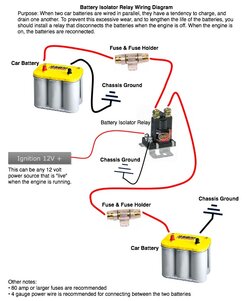Mudwisel
Well-Known Member
Lifetime Member
In most dual battery set ups the stinger is really just a relay that turns on a fuse block that runs of the batter. For the stinger to be used as true isolator you would not have it activated by key on . Your just running 2 batteries in parallel. With the stinger on in this configuration its like a bigger battery. When you use something like the true isolator between the batteries it will only let voltage go to second battery when primary is fully charged and it does this automatically. If the stinger is used as isolator you would need to activate it with a non keyed switch. You would only charge second battery with stinger activated. With switch off the batteries are isolated from each other but you are not automatically charging second battery. You have to activate the stinger to allow voltage from primary to also charge second





